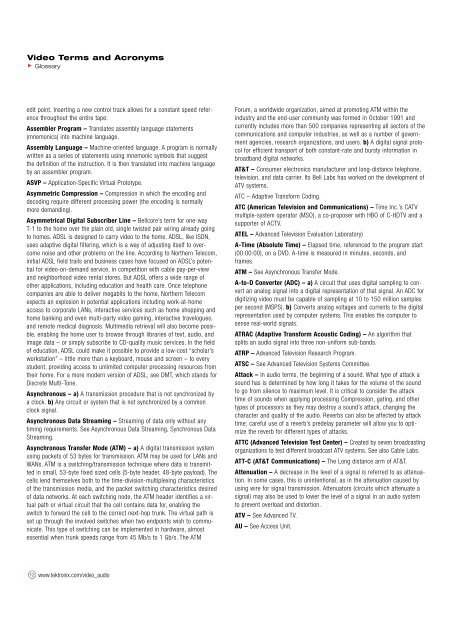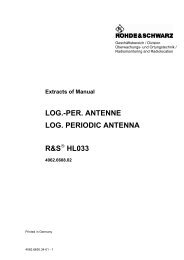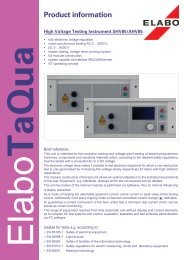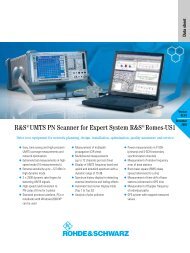Glossary of Video Terms and Acronyms - Isotest
Glossary of Video Terms and Acronyms - Isotest
Glossary of Video Terms and Acronyms - Isotest
Create successful ePaper yourself
Turn your PDF publications into a flip-book with our unique Google optimized e-Paper software.
<strong>Video</strong> <strong>Terms</strong> <strong>and</strong> <strong>Acronyms</strong><br />
<strong>Glossary</strong><br />
edit point. Inserting a new control track allows for a constant speed reference<br />
throughout the entire tape.<br />
Assembler Program – Translates assembly language statements<br />
(mnemonics) into machine language.<br />
Assembly Language – Machine-oriented language. A program is normally<br />
written as a series <strong>of</strong> statements using mnemonic symbols that suggest<br />
the definition <strong>of</strong> the instruction. It is then translated into machine language<br />
by an assembler program.<br />
ASVP – Application-Specific Virtual Prototype.<br />
Asymmetric Compression – Compression in which the encoding <strong>and</strong><br />
decoding require different processing power (the encoding is normally<br />
more dem<strong>and</strong>ing).<br />
Asymmetrical Digital Subscriber Line – Bellcore’s term for one-way<br />
T-1 to the home over the plain old, single twisted pair wiring already going<br />
to homes. ADSL is designed to carry video to the home. ADSL, like ISDN,<br />
uses adaptive digital filtering, which is a way <strong>of</strong> adjusting itself to overcome<br />
noise <strong>and</strong> other problems on the line. According to Northern Telecom,<br />
initial ADSL field trails <strong>and</strong> business cases have focused on ADSL’s potential<br />
for video-on-dem<strong>and</strong> service, in competition with cable pay-per-view<br />
<strong>and</strong> neighborhood video rental stores. But ADSL <strong>of</strong>fers a wide range <strong>of</strong><br />
other applications, including education <strong>and</strong> health care. Once telephone<br />
companies are able to deliver megabits to the home, Northern Telecom<br />
expects an explosion in potential applications including work-at-home<br />
access to corporate LANs, interactive services such as home shopping <strong>and</strong><br />
home banking <strong>and</strong> even multi-party video gaming, interactive travelogues,<br />
<strong>and</strong> remote medical diagnosis. Multimedia retrieval will also become possible,<br />
enabling the home user to browse through libraries <strong>of</strong> text, audio, <strong>and</strong><br />
image data – or simply subscribe to CD-quality music services. In the field<br />
<strong>of</strong> education, ADSL could make it possible to provide a low-cost “scholar’s<br />
workstation” – little more than a keyboard, mouse <strong>and</strong> screen – to every<br />
student, providing access to unlimited computer processing resources from<br />
their home. For a more modern version <strong>of</strong> ADSL, see DMT, which st<strong>and</strong>s for<br />
Discrete Multi-Tone.<br />
Asynchronous – a) A transmission procedure that is not synchronized by<br />
a clock. b) Any circuit or system that is not synchronized by a common<br />
clock signal.<br />
Asynchronous Data Streaming – Streaming <strong>of</strong> data only without any<br />
timing requirements. See Asynchronous Data Streaming, Synchronous Data<br />
Streaming.<br />
Asynchronous Transfer Mode (ATM) – a) A digital transmission system<br />
using packets <strong>of</strong> 53 bytes for transmission. ATM may be used for LANs <strong>and</strong><br />
WANs. ATM is a switching/transmission technique where data is transmitted<br />
in small, 53-byte fixed sized cells (5-byte header, 48-byte payload). The<br />
cells lend themselves both to the time-division-multiplexing characteristics<br />
<strong>of</strong> the transmission media, <strong>and</strong> the packet switching characteristics desired<br />
<strong>of</strong> data networks. At each switching node, the ATM header identifies a virtual<br />
path or virtual circuit that the cell contains data for, enabling the<br />
switch to forward the cell to the correct next-hop trunk. The virtual path is<br />
set up through the involved switches when two endpoints wish to communicate.<br />
This type <strong>of</strong> switching can be implemented in hardware, almost<br />
essential when trunk speeds range from 45 Mb/s to 1 Gb/s. The ATM<br />
12 www.tektronix.com/video_audio<br />
Forum, a worldwide organization, aimed at promoting ATM within the<br />
industry <strong>and</strong> the end-user community was formed in October 1991 <strong>and</strong><br />
currently includes more than 500 companies representing all sectors <strong>of</strong> the<br />
communications <strong>and</strong> computer industries, as well as a number <strong>of</strong> government<br />
agencies, research organizations, <strong>and</strong> users. b) A digital signal protocol<br />
for efficient transport <strong>of</strong> both constant-rate <strong>and</strong> bursty information in<br />
broadb<strong>and</strong> digital networks.<br />
AT&T – Consumer electronics manufacturer <strong>and</strong> long-distance telephone,<br />
television, <strong>and</strong> data carrier. Its Bell Labs has worked on the development <strong>of</strong><br />
ATV systems.<br />
ATC – Adaptive Transform Coding.<br />
ATC (American Television <strong>and</strong> Communications) – Time Inc.’s CATV<br />
multiple-system operator (MSO), a co-proposer with HBO <strong>of</strong> C-HDTV <strong>and</strong> a<br />
supporter <strong>of</strong> ACTV.<br />
ATEL – Advanced Television Evaluation Laboratory)<br />
A-Time (Absolute Time) – Elapsed time, referenced to the program start<br />
(00:00:00), on a DVD. A-time is measured in minutes, seconds, <strong>and</strong><br />
frames.<br />
ATM – See Asynchronous Transfer Mode.<br />
A-to-D Converter (ADC) – a) A circuit that uses digital sampling to convert<br />
an analog signal into a digital representation <strong>of</strong> that signal. An ADC for<br />
digitizing video must be capable <strong>of</strong> sampling at 10 to 150 million samples<br />
per second (MSPS). b) Converts analog voltages <strong>and</strong> currents to the digital<br />
representation used by computer systems. This enables the computer to<br />
sense real-world signals.<br />
ATRAC (Adaptive Transform Acoustic Coding) – An algorithm that<br />
splits an audio signal into three non-uniform sub-b<strong>and</strong>s.<br />
ATRP – Advanced Television Research Program.<br />
ATSC – See Advanced Television Systems Committee.<br />
Attack – In audio terms, the beginning <strong>of</strong> a sound. What type <strong>of</strong> attack a<br />
sound has is determined by how long it takes for the volume <strong>of</strong> the sound<br />
to go from silence to maximum level. It is critical to consider the attack<br />
time <strong>of</strong> sounds when applying processing Compression, gating, <strong>and</strong> other<br />
types <strong>of</strong> processors as they may destroy a sound’s attack, changing the<br />
character <strong>and</strong> quality <strong>of</strong> the audio. Reverbs can also be affected by attack<br />
time; careful use <strong>of</strong> a reverb’s predelay parameter will allow you to optimize<br />
the reverb for different types <strong>of</strong> attacks.<br />
ATTC (Advanced Television Test Center) – Created by seven broadcasting<br />
organizations to test different broadcast ATV systems. See also Cable Labs.<br />
ATT-C (AT&T Communications) – The Long distance arm <strong>of</strong> AT&T.<br />
Attenuation – A decrease in the level <strong>of</strong> a signal is referred to as attenuation.<br />
In some cases, this is unintentional, as in the attenuation caused by<br />
using wire for signal transmission. Attenuators (circuits which attenuate a<br />
signal) may also be used to lower the level <strong>of</strong> a signal in an audio system<br />
to prevent overload <strong>and</strong> distortion.<br />
ATV – See Advanced TV.<br />
AU – See Access Unit.





